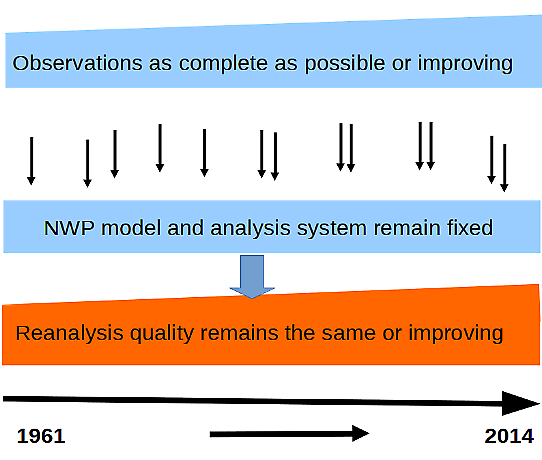Weather forecasting models and the analysis procedures are improved and enhanced all the time e.g. with increased resolution and methodology. The ever increased quality of the resulting analyses makes it difficult to use a long time series over years and decades. Especially for climate monitoring it is a requirement to have a fixed system for doing the analyses for all the years. A reanalyses can resolve those issues.
Weather forecasting is based on an analysis of the current state of the atmosphere and the surface of land and sea. The forecasts are made with mathematical and physical computer models starting from the analysis of the current state. The temperatures, winds, pressure, moisture, cloud contents and other variables are mapped at regular points in space and time. The analysis is using as many observations as possible, but there are often not enough of them or they are not exactly in the right places.
Methodology for reanalyses
By using the same model of the atmosphere's evolution as is used for forecasting, a prior estimate – a first guess of the analysis, can be obtained. That model forecast has in its turn used earlier analyses based on earlier observations and from other places. The process of repeatedly combining such a first guess with observations is called data assimilation.
The analysis procedure updates the first guess with small corrections. The procedure also uses physical and statistical relationships of the atmosphere when interpreting the observational data. The analyses can in these ways produce values of the atmosphere and the surface away from the observations. To accommodate a wide range of use and applications, the analyses are produced for a regular grid every so many kilometres apart (usually 10-50 or better for small areas).
Even though the analyses are made for the purpose of accurate weather forecasting, the mapped variables of the atmosphere have an important value on their own. Many applications and users want to know the best estimate of the atmospheric state at any given time, for assessing past weather events, for statistics of the climate in a location or an area or for running other fine scale models or validating climate models.

Benefits of reanalyses
The old analyses made a long time ago can be much improved by employing a more recent operational system, both due to improved methodology and higher resolution. A number of meteorological centres have re-run their old analyses with their most recent system. This frozen software system is executed for the whole contiguous time period of e.g. 50 years thereby giving as consistent climate analysis as possible when using both observations and a numerical weather prediction system. This is called reanalysis.
Another important reason for doing this is that more observations can be made available after the time of the real time analyses. It is both through receiving late-coming data and especially through data rescue of old observational archives often on paper. The EU funded project UERRA has a Data Rescue (and Development) activity where over 8 million data have been digitised from several countries in and around Europe and on a sub-daily scale.
Reanalysis world wide
Global centres have made a number of generations of reanalyses and there are also a few regional reanalyses covering e.g. North America or Europe or sometimes only a part of Europe. SMHI has performed European reanalyses from 1979-2014 in the EU Framework 7 Project EURO4M and in the following project UERRA. The work is continuing in the European Copernicus program.